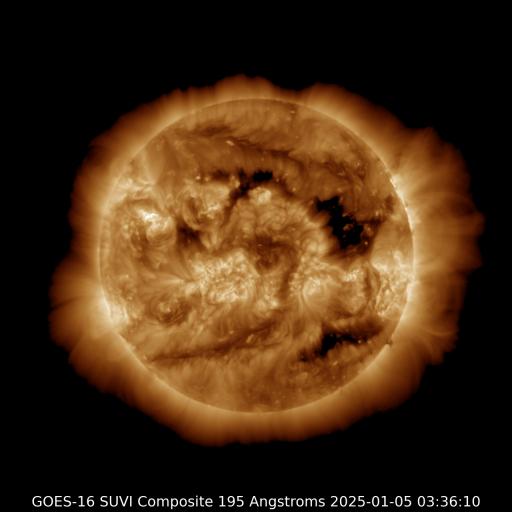Viewing archive of Monday, 31 October 2022
Daily bulletin on solar and geomagnetic activity from the SIDC
Issued: 2022 Oct 31 1233 UTC
SIDC Forecast
Solar flares
C-class flares expected, (probability >=50%)
Geomagnetism
Quiet (A<20 and K<4)
Solar protons
Quiet
| 10cm flux | Ap | |
|---|---|---|
| 31 Oct 2022 | 133 | 009 |
| 01 Nov 2022 | 135 | 015 |
| 02 Nov 2022 | 135 | 011 |
Bulletin
The solar flaring activity over the past 24 hours was at low levels with isolated low C-class flaring. There are four numbered active regions on the visible solar disk all classified as magnetic type beta. NOAA 3135 underwent some development and is currently the largest active region, but has remained quiet. NOAA 3130 has rotated almost fully behind the west limb producing a C1.3-class flare. NOAA 3131 remained stable and NOAA 3133 remained small producing a C1.1-class flare. The flaring activity is expected to be at very low to low levels over the next 24 hours with isolated C-class flaring.
No Earth-directed coronal mass ejections (CMEs) were detected in the available coronagraph imagery over the past 24 hours.
The greater than 10 MeV proton flux was at nominal levels in the past 24 hours and is expected to remain so in the next 24 hours. The greater than 2 MeV electron flux has been primarily above the1000 pfu threshold over the past 24 hours and is expected to remain so over the next 24 hours. The 24h electron fluence has reached moderate levels and is expected to remain so over the next 24 hours.
Over the past 24 hours the solar wind parameters (ACE and DSCOVR) continued to be under the influence of the high speed stream (HSS) from a positive polarity coronal hole. The solar wind velocity has followed a declining trend, ranging from 570 to 436 km/s. The interplanetary magnetic field was weak with a maximum value of 5.6 nT and a minimum Bz of -4.8 nT. The magnetic field was predominantly in the positive sector (directed away from the Sun). The solar wind parameters are expected to remain enhanced over the next 24 hours under the waning influence of the HSS from the currently geo-effective positive polarity coronal hole and an expected new HSS arrival later tomorrow.
The geomagnetic conditions over the past 24 hours were quiet to unsettled. Quiet to active geomagnetic conditions are expected over the next 24 hours in response to the ongoing HSS with possible isolated active periods and a chance for reaching a minor storm level later on Nov 1st.
Today's estimated international sunspot number (ISN): 057, based on 13 stations.Solar indices for 30 Oct 2022
| Wolf number Catania | /// |
| 10cm solar flux | 131 |
| AK Chambon La Forêt | 024 |
| AK Wingst | 014 |
| Estimated Ap | 014 |
| Estimated international sunspot number | 074 - Based on 20 stations |
Noticeable events summary
| Day | Begin | Max | End | Loc | Strength | OP | 10cm | Catania/NOAA | Radio burst types | |
|---|---|---|---|---|---|---|---|---|---|---|
| None | ||||||||||
Provided by the Solar Influences Data analysis Center© - SIDC - Processed by SpaceWeatherLive
All times in UTC
Current data suggests there is a slight possibility for aurora to appear at the following high latitude regions in the near future
Gillam, MB, Whitehorse, YT, Yellowknife, NTAnchorage, AK, Fairbanks, AK, Juneau, AK
Latest news
Latest forum messages
Support SpaceWeatherLive.com!
A lot of people come to SpaceWeatherLive to follow the Sun's activity or if there is aurora to be seen, but with more traffic comes higher server costs. Consider a donation if you enjoy SpaceWeatherLive so we can keep the website online!

Latest alerts
06:30 UTC - Type II Radio Emission
Begin Time: 08/04/2025 05:53 UTC Estimated Velocity: 456km/sec.
05:15 UTC - Hemispheric Power Index
The OVATION model predicts the Hemispheric Power Index to reach 50GW at 06:02 UTC
00:55 UTC - Coronal hole
A southern hemisphere coronal hole is facing Earth. Enhanced solar wind could arrive in ~3 days
Monday, 7 April 2025
20:45 UTC - Geomagnetic activity
Active geomagnetic conditions (Kp4) Threshold Reached: 20:39 UTC
17:33 UTC - Hemispheric Power Index
The OVATION model predicts the Hemispheric Power Index to reach 51GW at 18:18 UTC
Space weather facts
| Last X-flare | 2025/03/28 | X1.1 |
| Last M-flare | 2025/04/05 | M1.0 |
| Last geomagnetic storm | 2025/04/06 | Kp5 (G1) |
| Spotless days | |
|---|---|
| Last spotless day | 2022/06/08 |
| Monthly mean Sunspot Number | |
|---|---|
| March 2025 | 134.2 -20.4 |
| April 2025 | 151.3 +17.1 |
| Last 30 days | 135.2 -4.5 |




